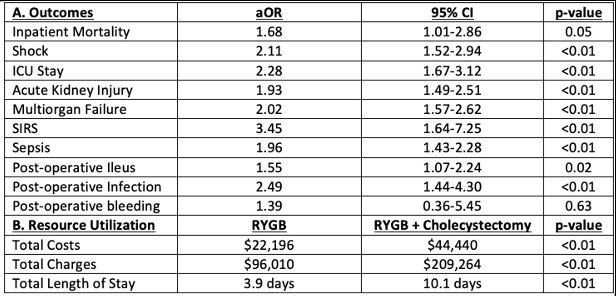Back to 2024 Abstracts
SIMULTANEOUS ROUX-EN-Y GASTRIC BYPASS AND CHOLECYSTECTOMY NATIONWIDE OUTCOMES
Paul T. Kröner
*2, Christopher C. Thompson
11Division of Gastroenterology, Hepatology and Endoscopy, Brigham and Women's Hospital, Boston, MA; 2Mayo Clinic in Florida, Jacksonville, FL
IntroductionRapid weight loss following obesity surgery is a known risk factor for the development of cholelithiasis and, by extension, choledocholithiasis. The management of choledocholithiasis in patients with Roux-en-Y gastric bypass (RYGB) introduces a significant challenge to the endoscopic treatment of choledocholithiasis. While proposed by some as a potential solution, simultaneous cholecystectomy (CCY) at the time of RYGB has been a subject of significant debate, and is currently not recommended given concerns for increased surgical times, post-procedural complications and length of hospitalization. The aim of this study was to explore and update knowledge of outcomes of concomitant CCY and RYGB in the U.S.
MethodsRetrospective, observational study using the NIS 2020. Patients with ICD10CM codes for CCY and RYGB were included. The primary outcome was the inpatient mortality of patients undergoing simultaneous CCY and RYGB compared to RYGB alone. Secondary outcomes were in-hospital and post-operative morbidity odds, as measured by shock, ICU need, acute kidney injury, organ failure, sepsis, postoperative ileus, infection and bleeding. Hospital costs, charges and length of hospitalization (LOS) were estimated and compared. Multivariate regression analyses were then used to adjust for sex, Charlson Comorbidity Index, income by patient zip code, hospital region, location, size and teaching status.
ResultsA total of 63,450 patients underwent RYGB in the study period, of which 2,945 (4.6%) underwent simultaneous RYGB. The average age was 55.1 years for patients undergoing simultaneous procedures, while 48.1 years in patients undergoing RYGB alone. 78.2% of patients undergoing RYGB alone were female, while 66.2% of patients undergoing simultaneous CCY and RYGB were female. Patients undergoing simultaneous CCY and RYGB displayed significantly increased odds of inpatient mortality compared to those undergoing RYGB alone (aOR: 1.68, p=0.05). Patients undergoing simultaneous CCY and RYGB also displayed increased odds of shock, ICU stay, organ failure, sepsis, post-operative ileus and post-operative infection as compared to patients undergoing CCY alone. Patients undergoing simultaneous CCY and RYGB displayed more than double hospital costs, hospitalization charges and LOS compared to those undergoing RYGB alone.
ConclusionsPatients undergoing simultaneous CCY and RYGB had increased odds of inpatient mortality, as well as increased odds of morbidity, postoperative complications and resource utilization compared to patients undergoing RYGB alone. This study updates existing knowledge and continues to suggest that simultaneous CCY and RYGB carries elevated risks of poor short-term outcomes and increased financial burden. Therefore, these findings continue to support the current stance against the widespread use of these procedures simultaneously.

Table 1 – A. Adjusted odds ratios of selected outcomes in patients undergoing cholecystectomy with simultaneous Roux-en-Y Gastric Bypass compared to patients undergoing Roux-en-Y gastric bypass alone.
ICU: Intensive care unit; SIRS: Systemic inflammatory response syndrome; ARDS: Acute respiratory distress syndrome; RYGB: Roux-en-Y Gastric Bypass; aOR: Adjusted odds ratio; CI: Confidence interval.
Back to 2024 Abstracts
